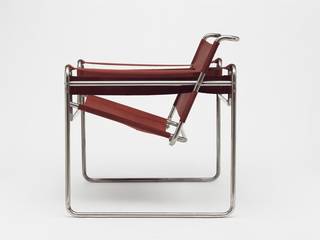From the 1920s, a new, experimental architecture was emerging. Traditional materials of stone, brick and wood made way for new construction techniques reliant on steel, concrete and glass, inspired by Modernist principles – open interiors and a lack of ornament – and the teachings of the Bauhaus school.
The Bauhaus
Let us together desire, conceive and create the new building of the future, which will combine everything — architecture and sculpture and painting — in a single form…
The Bauhaus was arguably the most influential architecture, art and design school of the 20th century. Founded in Weimar, Germany, in 1919 by architect Walter Gropius, it attracted some of the key figures in the evolution of Modernism.

At first the Bauhaus focused on individual handmade craft, but the school soon shifted to a more industrial focal point, merging art and technology and emphasising mass production. Furnishings created there, such as Marcel Breuer's tubular-steel Club Chair and Marianne Brandt's light fittings, fit this ethos of standardisation and uniformity.

The teaching was innovative and the work of both teachers and students had a huge impact, as did the building that Gropius designed when the school moved to Dessau in 1925. The structure is an asymmetrical collection of buildings that each express the work being done inside them. The teaching rooms, for instance, have small rows of windows whereas the workshops and studios are illuminated by walls of glass.

Posters of the time reflect the wholehearted newness of this architecture. The trappings of previous centuries, with their antiquated, crumbling furnishings, are slashed in red paint. Such posters suggest that the old architecture and its cultural influence is fading and will be replaced with brash, bold and excitingly Modern structures. The Bauhaus represented this new dawn, and its significance was felt nearly immediately.
Despite its reputation for rigour and excellence, the school was closed by Nazi authorities in 1933. Many of its members went abroad, where they were to disseminate Bauhaus ideas through their work and teaching.
Housing schemes
For architects in the mid-1920s, a utopian desire to create a better world also began to take shape. During this historical period, hundreds of thousands of people needed to be re-housed throughout Europe. Buildings, the architects envisioned, should not only respond to the needs of society but also actively liberate and elevate it.

Many designers and architects turned their focus towards mass housing schemes, few of which were ever completed. Exhibitions such as the 1927 Werkbund Exhibition in Stuttgart attempted to demonstrate how new techniques in construction, including prefabricated concrete, would pave the way for efficient future buildings. The housing plans, unfortunately, weren't always practical. Flat roofs, external staircases and glass walls offered little protection against the elements, and some schemes were denounced as crowded, stark cubes unsuitable for the families or workers in need.
Tools and technique
What did endure from the intense attention paid to experimental housing in the inter-war period, however, was the standardisation of the building process. New construction techniques relied on steel, concrete and glass rather than on the traditional materials of stone, brick and wood. Architects admired steel for its tensile strength, concrete for its resistance and glass for its ability to admit light. They sought innovative and expressive ways to reveal these properties.
Newfound emphasis on ventilation, hygiene, and the benefits of sunshine also permeated this new architecture. Crusaders for healthy living embarked on campaigns to divulge the health risks of the previous forms of housing, in favour of roof gardens, a lack of clutter, large windows and open-air spaces. Sub-standard housing was linked to tuberculosis, influenza pandemics and disease, so large social structures such as estates, schools and hospitals were re-envisioned to provide rationally designed, hygienic buildings.
Beyond housing: Modernist shop design

In the 1920s and 1930s architects also produced a number of striking shop designs. The growing number of department stores needed taller buildings and large open-plan spaces. Architects used the latest technologies of steel frames and large sheets of plate glass to meet this demand. There was a move towards cleaner and simpler lines. Façades were smooth and curved without fussy mouldings. New materials like Vitrolite, a type of opaque glass, gave the glossy finish of polished stone without expensive craftsmanship. Often the only form of decoration would be in the signage of the store's name.
Ugly or beautiful?
Stark, white homes, sanatorium-like environments and rigorous geometric plans didn't enchant everyone. Opponents criticised the 'loss of human warmth' in the sterile exteriors of modern design, but others felt that the clarity and originality of the concept imbued it with both spirit and beauty. As Modernism disseminated from its European origins to become a widespread international phenomenon, each country began to put its own vibrancy and vernacular twist on the movement.
Although attaching the term 'functional' to architecture meant that necessity – rather than beauty – was often seen as a modern architect's priority, humanism was never wholly absent. Modern architecture combined the intensity and fascination of order, transparency and standardisation with the simple splendor of clean, pure design.

